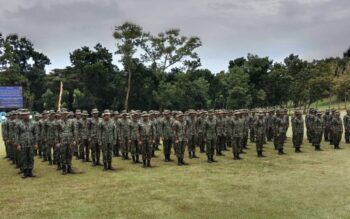DAVAO CITY (MindaNews / 21 May) – When Fr. Charlie Malapitan Inzon, Provincial Superior of the Oblates of Mary Immaculate (OMI), was ordained on Thursday afternoon as the sixth Bishop and Apostolic Vicar of the Vicariate of Jolo in Sulu, it was physically an intimate ceremony: only 10 of them inside the 1,800-seater Immaculate Conception Cathedral in Cotabato City, facing rows and rows of empty pews, while trying to observe social distancing at the altar.
But it was livestreamed for the world to see a Bishop’s ordination in the time of the COVID-19 pandemic, a preview into the “new normal.” In the traditional manner, it was aired live over the radio stations of the Notre Dame Broadcasting Corporation.
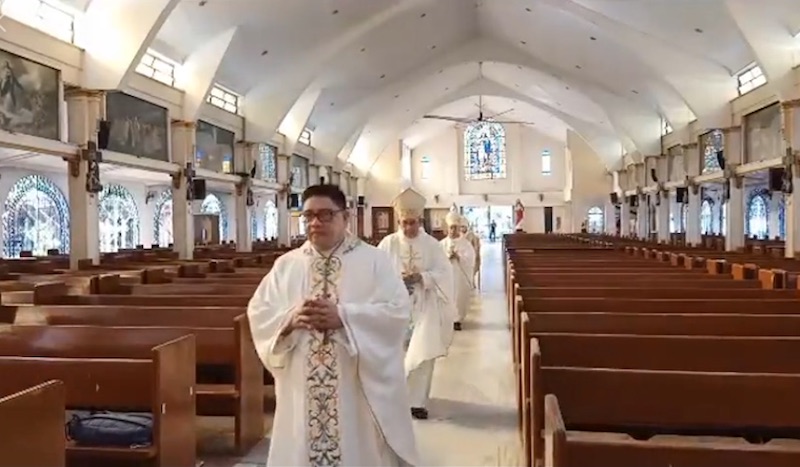 Fr. Charlie Inzon, Bishop Colin Bagaforo, Cardinal Oralndo Quevedo and Archbishop Angelito Lampon approach the altar of the 1,800-seater Immaculate Conception Cathedral in Cotabato CIty for the ordination of Inzon as Bishop of Jolo on 21 May 2020. In the time of COVID-19, only 10 persons were allowed to be at the ordination. Photo screengrabbed from OMI Philippines’ video
Fr. Charlie Inzon, Bishop Colin Bagaforo, Cardinal Oralndo Quevedo and Archbishop Angelito Lampon approach the altar of the 1,800-seater Immaculate Conception Cathedral in Cotabato CIty for the ordination of Inzon as Bishop of Jolo on 21 May 2020. In the time of COVID-19, only 10 persons were allowed to be at the ordination. Photo screengrabbed from OMI Philippines’ video
In pre-COVID times, the consecration of a new Bishop is a major celebration, attended by hundreds of Bishops and priests and nuns from Mindanao and other parts of the country, family, friends and parishioners. The Cotabato City cathedral would have been jampacked and if Inzon had been ordained before COVID, his sister, brother and two aunts who are nuns, would have been present.
In Thursday’s ordination, Cotabato City Archbishop Angelito Lampon, whom Inzon succeeded as Bishop of Jolo, was the main consecrator and Cardinal Orlando Quevedo and Kidapawan Bishop Colin Bagaforo were the co-consecrators. The six others with them were two Oblate priests, two diocesan priests, one organist and one singer. “That’s 10,” Inzon said.
Cotabato City is still under general community quarantine (GCQ). Nationwide, mass gatherings are still prohibited, churches are still closed but Section 4.12 of the Omnibus Guidelines of the Inter-Agency-Task Force on COVID-19 for areas under GCQ like Cotabato City provides that “while adhering to the prescribed minimum health standards, religious gatherings are not encouraged but in any case should be not more than 10 persons.”
Inzon, a social psychologist, said friends had asked him how he felt being ordained in the midst of a pandemic “where the social world is re-ordering forcibly and painfully.”
“I said to them that my celebration is no thrills, no frills but plain and simple, pure, and meaningful consecration …. for the Lord himself is the center that shines and stands out as I receive His Holy Spirit through my Bishop-consecrators. It’s so beautiful, so wonderful, to receive the Lord in simplicity. The Lord … is the center of the celebration. And I am truly grateful. All the essentials are present. So free. So cool. No chains, no restrictions can stop us from receiving and celebrating God’s gifts, God’s grace is super abundant and unrestrained. It is Him that we want and desire. …”
He said the celebration is “rare and unprecedented as well as restricted — with 10 people in attendance – but of course with thousands watching. I have no doubt about the validity and catholicity of this celebration.What more can I ask?”
While locked down in the OMI Provincial House in Cotabato City (part of government’s precautionary measures to prevent the spread of COVID-19), Inzon, whose first assignment as priest was in Jolo from 1993 to 1994, received the news on April 4 that he was appointed by Pope Francis to be the Bishop and Apostolic Vicar of Jolo.
“Preach and work among the poor”
Inzon’s ordination day, Cardinal Quevedo told MindaNews, is also “Oblate Day,” the Feast of St. Eugene de Mazenod, Bishop of Marseille and founder of the OMI. “St. Eugene, a nobleman, preferred to preach and work among the poor. He died on May 21, 1861,” he said.
The OMI missionaries in Mindanao are assigned in the peripheries, in the Moro-dominated island provinces of Sulu and Tawi-tawi, and among the Lumad (Indigenous Peoples) and settler areas in some parts of mainland Mindanao.
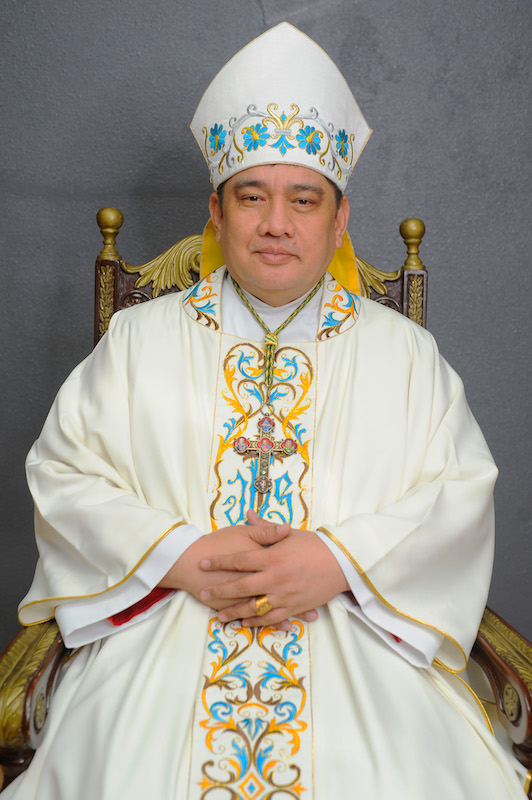 Bishop Charlie Malapitan Inzon, OMI, Apostolic Vicar of the Vicariate of Jolo in Sulu.
Bishop Charlie Malapitan Inzon, OMI, Apostolic Vicar of the Vicariate of Jolo in Sulu.
In his homily, Quevedo, Archbishop Emeritus of Cotabato reminded Inzon that pastoral charity impels the Bishop to be a Good Shepherd, concerned about everyone in his diocese. “He has to know their situation in life. He must be able to relate with them in kindness and compassion, rich or poor, Christians, Lumads, Muslims and peoples of other faiths. For all the people of his diocese he is a servant leader and companion in the common journey to God’s Kingdom.”
He also reminded Inzon of two special dimensions in his future life and ministry as Bishop of Jolo: to “be like Jesus the Poor man” and to “engage in dialogue for Peace.”
“The Vicariate of Jolo, which covers the two provinces of Sulu and Tawi-Tawi, is a privileged place for inter-religious dialogue. As a servant leader of all the peoples of your Vicariate, the Holy Spirit is surely calling you to lead in this dialogue for peace and harmony.”
A day before his ordination, Inzon made his Profession of Faith and Oath of Fidelity to the Church and the Holy Father at the chapel of the Archbishop Mongeau Center in Cotabato City, before Lampon and Quevedo. The event was also livestreamed.
10 years in Jolo
Inzon was born on November 24, 1965 in Sogoy, Castilla in Sorsogon, finished Elementaryin Putiao, Sorsogon, high school in Elpidio Quirino High School in Manila.
He entered the Congregation of the Missionary Oblates of Mary Immaculate in 1982, graduated AB Philosophy at teh Notre Dame University in Cotabato City in 1988, made his perpetual profession on September 8, 1990 and was ordained priest on April 24, 1993 in Caloocan City.
He finished Theology at the Loyola School of Theology at the Atheeo de Manila University (ADMU) in 1993, his MA in Pastoral Ministry in 1994 and Doctorate in Psychology also at the ADMU in 2008.
Inzon is no stranger to Jolo. After his AB Philosphy course at the NDU in 1988, Lampon, then one of his formators, sent him to Jolo for a year. After his ordination, his first assignment was Jolo from 1993 to 1995. He returned to Jolo in 2007 and spent seven years at the Notre Dame of Jolo College as Director of Research from 2007 to 2010, chaplain from 2008 to 2010, Dean of the Graduate School from 2009 to 2010 and President from 2010 to 2014.
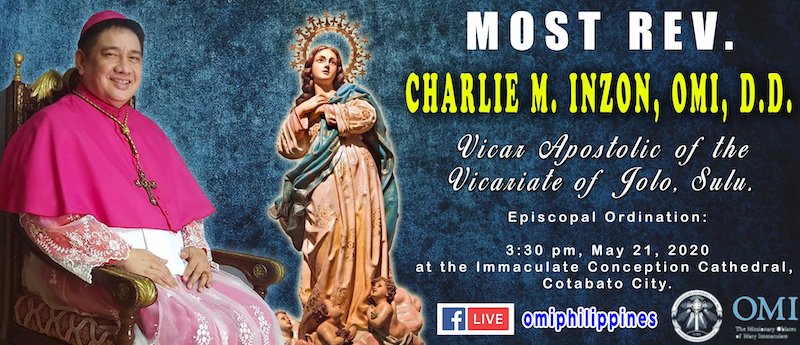 Inzon had also served as head of the missionary station of Batu-Batu, Tawi-Tawi from 1995 to 1998; parish vicar of Our Lady of Lourdes Parish in Bagong Barrio, Caloocan City f rom 1998-1999; parish vicar of the Sto. Niño parish in Midsayap, North Cotabato from 1999 to 2000; director of OMI College Seminary in Quezon City from 2000 to 2007; and President of Notre Dame University in Cotabato City from 2014 to 2018. He was named OMI Provincial Superior in 2018.
Inzon had also served as head of the missionary station of Batu-Batu, Tawi-Tawi from 1995 to 1998; parish vicar of Our Lady of Lourdes Parish in Bagong Barrio, Caloocan City f rom 1998-1999; parish vicar of the Sto. Niño parish in Midsayap, North Cotabato from 1999 to 2000; director of OMI College Seminary in Quezon City from 2000 to 2007; and President of Notre Dame University in Cotabato City from 2014 to 2018. He was named OMI Provincial Superior in 2018.
The five Bishops of Jolo, all from the OMI congregation are: Francis Joseph McSorley (from 1954), Philip Francis Smith (from 1972), George Eli Dion (from 1980), Benjamin de Jesus from 1991 to 1997, and Lampon from 1997 until his appointment as Archbishop of Cotabato on November 6, 2018.
Borrowed items
Preparing for the consecration of a Bishop in pre-COVID-19 times is a grand production — from invitations to reception, floral arrangements and even what to wear. But under COVID-19 when stores are closed and movement is restricted, that poses a problem.
In his ‘thank you’ speech at the end of the ceremonies, Inzon narrated how the problem was solved, thanks to the previous bishops of Jolo.
Lampon, his immediate predecessor in Jolo, “gave me four miters, then this chasuble and also his skull cap that I use now.”
“I could not move around to buy other items needed for this consecration, but the Holy Spirit led me the way,” Inzon said.
“The way” is the memorabilia room at the OMI Provincial House. “This ring and pastoral staff are from Bishop Ben de Jesus – the 4th Vicar Apostolic of Jolo, this pectoral cross and my cassock are from Bishop Smith, the 2nd Vicar Apostolic of Jolo. My miter and chasuble are from Archbishop Lampon, the 5th Vicar Apostolic of Jolo,” Inzon said, adding his predecessors “saw to it that I be ordained.”
The sixth Bishop of Jolo, according to Quevedo, is also the sixth Bishop to be ordained in the Cotabato cathedral.
“Jolo will make or break you”
Lampon is not just Inzon’s predecessor in the Vicariate of Jolo, he was also his formator in the seminary, who assigned him to Jolo after graduating from AB Philosophy in NDU in 1988.
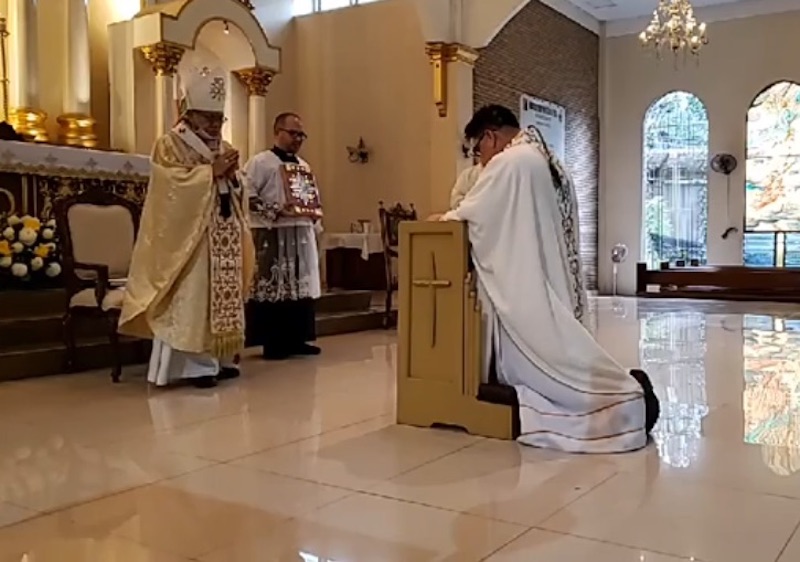 Cotabato Arcbhishop Angelito Lampon is main consecrator at the ordination of Fr. Charlie Inzon as the Bishop of Jolo on 21 May 2020 at hte Immaculate Conception Cathedral in Cotabato City. Inzon succeeds Lampon who served for two decades in Sulu. Photo screengrabbed from OMI Philippines’ video
Cotabato Arcbhishop Angelito Lampon is main consecrator at the ordination of Fr. Charlie Inzon as the Bishop of Jolo on 21 May 2020 at hte Immaculate Conception Cathedral in Cotabato City. Inzon succeeds Lampon who served for two decades in Sulu. Photo screengrabbed from OMI Philippines’ video
“I still vividly recall when he promoted all of my classmates straight to Theology in Manila and excluded me because he said, I was not yet ready. He gave so many reasons and excuses why Jolo should be a good place for me before Theology. He said, ‘Jolo will make or break you.’ I did not understand then his decision. Now, it’s crystal clear,” Inzon said.
But when will he proceed to Jolo?
Cardinal Quevedo said Inzon’s installation as Apostolic Vicar at the Our Lady of Mt. Carmel in Jolo is on May 28. “Archbishop Lito (Lampon) will install him. But no flights till end of May so I don’t know what will happen,” he said.
Inzon told MindaNews his installation will depend on when the travel ban will be lifted. “As soon as there is flight, probably June,” the Bishop said. (Carolyn O. Arguillas / MindaNews)
READ:
HOMILY: The Vicariate of Jolo is a privileged place for inter-religious dialogue
JOLO BISHOP’s MESSAGE: It’s so beautiful, so wonderful to receive the Lord in simplicity
